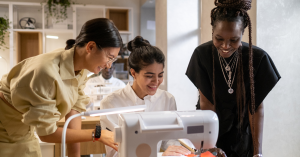Do you want to stand out as a fashion designer amidst the competition? The difference between a design people remember and one they forget is a fashion designer’s skill & expertise. You will need to work on building and perfecting technical, software, and communication skills to become a successful fashion designer.
If you’re reading this, you likely have a passion for fashion and design and the talent to build a career. What you need next is to master a few essential skills. From understanding fashion basics, trendspotting, and forecast analysis, to technical skills like pattern-making, draping, and sewing complex patterns, you will need to ensure you are versatile and adaptable.
Being familiar with popular fashion design software is essential for a rewarding career. Tools like Adobe Photoshop & Illustrator and CLO 3D can help you digitize most of your process and make it more efficient.
This article will explain the essential technical, digital, and communication skills you need to become a successful designer.
What Does a Fashion Designer Do?

Versatility is one of the most valuable skills for a fashion designer. The daily responsibilities in design include research, concept development, selecting fabrics and trims, and overseeing the production process.
- Research – There are different types of research that fashion designers need to conduct. You would research consumer behavior trends, analyze markets, & look at forecasts. You might need to research concepts, silhouettes, fabrics, and cultural aspects related to a collection too. A fashion designer’s skill in research & analysis can impact their design process and the outcome. Working on your research skills will help you stay updated, and come up with creative & relevant designs.
- Concept Development & Design – The design process includes looking at references, creating mood boards, deciding on a color palette & sketching ideas. This is where you choose what your final product might look like, what trims and details you would use, and figure out what the final product might look like. You can experiment with designs, explore materials, infuse trends, & refine your ideas. The final step in your design process would be to illustrate the designs manually or digitally for the next steps in production.
- Range-Planning – A designer plans the number of styles, assigns numbers to identify them, & calculates the production and selling prices of each piece. They review last season’s sales reports to work on weak areas and aim for higher revenue. Range plans include financial and product details that design, production, and sales teams refer to while developing collections. Along with the numbers, these can contain rendered illustrations of the products, their technical sketches, and other important details that might be helpful in the process.
- Creating Specification Sheets – This includes Making detailed technical drawings that show all the important details of a design. It mentions measurement details, trims and embellishments, finishes, and other construction guidelines. It makes the communication between different teams effective and helps minimize the risk of errors. It’s also a great way to keep a record of the product details in case it needs to be produced again.
- Overseeing Production – Fashion designers are required to oversee the production process, supervise quality checks, and ensure the final product matches your visualized design. You will be required to work with a team of manufacturers, merchandisers, production assistants, & suppliers. To oversee production, you need technical knowledge about the process as well as great communication & time-management skills. This would ensure the products are up for sale on time.
How is Skill Development a Game-Changer for a Fashion Design Career?

The fashion industry is constantly changing. Staying relevant in a dynamic environment requires constant upskilling and staying in touch with the latest trends. Learning new skills and working on the current ones can help you stand out in the competitive realm.
Mastering skills can help get better opportunities, aim for higher salaries, & stay relevant in the industry.
- You can specialize in a niche. There are paid & free courses that you will find online. If you want to enroll in an offline course, you can check out design schools that offer short-term courses.
- Stay updated about the global and domestic fashion trends. You can follow forecasters, international and Indian designers, Stylists, & celebrities who are trendsetters. You can also follow academicians who work in forecasting and related fields to know about the latest developments.
- Learn the latest software. With new and innovative digital tools flooding the industry, companies might want to shift to more convenient, user-friendly tools. Find the ones that meet industry standards and master them to expand your horizons as a designer.
6 Key Fashion Designing Skills For a Rewarding Career
Fashion Design can be a lucrative career option if you master the key skills. Practice your skills & be aware of what is happening in the industry to stay relevant and make your collections stand out.
We have shortlisted some key skills you must know for a successful career.
- Strong Creative drive : A strong creative drive helps you come up with unique & original designs. It will make your collections look fresh & more put-together. The more creative solutions you come up with, the more recognizable & memorable your brand voice will be.
Keeping your creativity alive is a continuous process –
-
- Keep up with the fashion trends.
- Practice sketching, pattern drafting, & software skills.
- Explore new cultures, trends, and styles for inspiration.
- Take feedback & implement them in your work.
- Read about your niche, watch movies and fashion shows, & make sure you are aware of the pop culture references.
- Technical Skills: To create a unique product, you must be well-acquainted with some essential hard skills.
- Research Skills: Fashion designers need to know how to research consumer behavior, competitors, industry trends, cultures, aesthetics, and different styles. Effective research skills form the basis of any design process & help make the collections authentic. To research relevant information, aspiring designers can follow trendsetters, read designer blogs and articles, and explore various cultures and their fashion A good place to start is to follow trending hashtags & keep up with what’s new.
- Understanding Trend Forecast : Understanding the mood of a season or a year is necessary for designers to meet consumer needs and stay ahead of the curve. It helps gauge consumer preferences and align products in a way that brings in more revenue. Following global forecasters like WGSN, Promostyl, & Peclers Paris and going through their seasonal trend reports can provide a route map for your collections. Pantone and other similar companies publish color forecast reports for designers around the world to follow. These allow you to ensure your designs are standing out & keeping up with the time.
- Illustration Skills – While you don’t need perfect artistic skills to become a designer, good sketches and illustrations can do wonders for your career. You can use quick sketches while brainstorming, make rough sketches while you design, and use rendered illustrations to visualize the final product. Explore different styles & mediums and experiment with your illustrations. Focus on neatness and clarity. Good illustrations make it easier to convey ideas and communicate with the teams.
- Pattern-Making – Patterns are like the blueprints or templates for clothing. These are life-sized technical drawings that are traced onto the fabric. Fashion designers must understand how to draft complex patterns and transfer them onto the fabric. Helen Joseph Armstrong’s book on Pattern-Making for Fashion Design is a great option if you want to start learning pattern development. There are also basic and advanced online tutorials that you can follow.
- Draping – Fabrics are sometimes positioned and manipulated on a dress form using pins and temporary hand stitches. This technique is known as draping. Many designers prefer draping because of the creative freedom it allows. Draping is used to visualize a design in 3D, understand the fit & fall of a garment, and experiment with the silhouette.
- Sewing – Sewing helps understand and consider the feasibility of a garment or an accessory while designing. It allows designers to understand & explore different materials and how they would shape into final products.
- Styling Skills – Fashion designers need to visualize how they want to style their designs to understand if they would create a cohesive look and attract consumers. Designers need to mix and match pieces from their collections to create a visually appealing ensemble. Styling optimizes trends & puts color theory to use. It requires knowledge of body types and how to style them. Go through fashion and lifestyle magazines & websites for inspiration, and gather some industry experience through internship programs.
- Marketing – fashion design has a multi-disciplinary approach. It is client-based and is highly influenced by trends. Marketing skills are essential for studying consumer behavior patterns and positioning products the right way. With the necessary skills, designers can build a brand, make it recognizable, & make their product reach potential buyers.
- Software Skills: The fashion industry is fast-paced & ever-changing. As a designer, you are expected to keep up with the rapid digitization and be proficient in fashion design software. From 2D illustration software like Adobe Photoshop & Illustrator to advanced software like CLO 3D and other pattern-making and digital draping software, you need to be familiar with it all. Continuous upskilling & exploring the latest software are some of the best ways you can work on your digital skills. Access digital libraries, experiment with different structures and cuts, and work with different styles and techniques to keep getting better at it.
- Communication Skills: A fashion designer’s skills include both technical and soft skills. You need to have expertise in designing & styling. At the same time, you would also need to communicate your ideas to your team members and other teams involved in the process. Fashion designers need communication skills to exchange ideas in a diverse work environment. They need to explain their design process and present their concepts and collections. They interact with clients, artisans, manufacturers, and other people involved in the supply chain. Avoiding misunderstanding and conflicts through effective communication is an integral part of being a designer. These skills hugely contribute to building healthy professional relationships. As a designer, working on your communication skills would play an important role in collaborating with professionals, reaching out to recruiters, and networking with industry experts.
- Attention to Detail: A good design is all about detail. From research to production, paying attention to the tiniest details can avoid wastage, make the process more efficient, and make the outcome fully functional and appealing. Developing an eye for intricacies can enhance your value as a creative professional and lead to a fun and rewarding career.
- Time-Management & Problem-Solving: Designers are often required to multitask. They have to handle multiple projects, oversee production, communicate with teams, and meet deadlines. This requires extensive planning, scheduling & planning. Time management skills are crucial for maintaining a work-life balance in a demanding field. Designing is a complex process with multiple steps. The ability to come up with innovative solutions to design problems leads to authentic design choices and increased consumer satisfaction.
How to Develop and Enhance These Skills?

Once you know what skills you need to be a fashion designer, you can look for fashion design courses that provide a structured curriculum aimed at building these skills. A formal training is important to get acquainted with subject-matter knowledge, hands-on training, & industry insights. It opens doors for aspiring designers and allows them to network with acclaimed professionals from the industry.
- Institutes & Programs
In India, reputed institutes like NIFT, NID, & AAFT offer degree & PG diploma courses in fashion design. If you want to enroll in these institutions, you will need to appear in Design Aptitude Tests/Personal Interviews conducted by the institutes.
| Course | Duration (in years) |
|---|---|
| B.Des in Fashion Design | 4 |
| B.Sc in Fashion Design | 3 |
| M.Des in Fashion Design | 2 |
| M.Sc in Fashion Design | 2 |
| Diploma in Fashion Design | 2-3 |
- Industry Experience
Fashion Designers’ skills are truly put to use when they start stepping into the professional space. Here are a few ways you can start your professional journey and experience the industry.
-
- Attend workshops and seminars by industry experts
- Intern with apparel brands, designers, and stylists
- Collaborate with fellow designers, photographers, & stylists on independent projects
- Start freelancing and work on different types of projects
- Reach out to your network for part-time work opportunities
Practical Tips from Industry Experts
Say you have all the skills, degrees, and even some work experience. How do you look for better opportunities? How do you stay relevant & updated?
Here’s what the experts suggest –
-
- Regularly update your portfolio.
- Work on building a personal brand.
- Build a social media presence for yourself.
- Work on the skills you have and learn some new ones.
- Collaborate with other professionals.
- Attend events and network extensively.
- Be confident with your experimentation and exploration.
Conclusion
Opportunities & success can really depend on a fashion designer’s skill and their willingness to learn new things. Versatility and adaptability go a long way in any creative profession. As a designer, you are going to need excellent communication skills, be tech-savvy and know the latest software, & master pattern-making, sewing, and other technical skills. You will need to know trendspotting, understand forecasts, have an idea of different types of aesthetics, know color theory, and be able to style well.
Start by understanding how to become a successful fashion designer and learn the skills you need for it. Pursue short-term courses, specialize in a niche you are interested in, learn the latest software, and always stay updated on the trends.
You can pursue formal courses with structured curriculums that would help develop all the necessary skills you need for a rewarding career. These are skill-oriented and provide knowledge and industry insights so you can navigate the professional world with ease. AAFT University offers a range of courses for aspiring fashion designers that you can check out.
Explore More Related Articles:
Explore the Fashion Designer Salary in India

